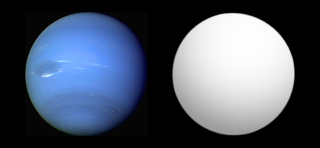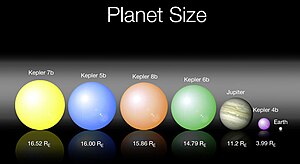
Kepler-7b is one of the first five exoplanets to be confirmed by NASA's Kepler spacecraft, and was confirmed in the first 33.5 days of Kepler's science operations. It orbits a star slightly hotter and significantly larger than the Sun that is expected to soon reach the end of the main sequence. Kepler-7b is a hot Jupiter that is about half the mass of Jupiter, but is nearly 1.5 times its size; at the time of its discovery, Kepler-7b was the second most diffuse planet known, surpassed only by WASP-17b. It orbits its host star every five days at a distance of approximately 0,06 AU. Kepler-7b was announced at a meeting of the American Astronomical Society on January 4, 2010. It is the first extrasolar planet to have a crude map of cloud coverage.

Kepler-4b, initially known as KOI 7.01, is an extrasolar planet first detected as a transit by the Kepler spacecraft. Its radius and mass are similar to that of Neptune; however, due to its proximity to its host star, it is substantially hotter than any planet in the Solar System. The planet's discovery was announced on January 4, 2010, in Washington, D.C., along with four other planets that were initially detected by the Kepler spacecraft and subsequently confirmed by telescopes at the W.M. Keck Observatory.

Kepler-5b is one of the first five planets discovered by NASA's Kepler spacecraft. It is a hot Jupiter that orbits a subgiant star that is more massive, larger, and more diffuse than the Sun is. Kepler-5 was first flagged as the location of a possibly transiting planet, and was reclassified as a Kepler Object of Interest until follow-up observations confirmed the planet's existence and many of its characteristics. The planet's discovery was announced at a meeting of the American Astronomical Society on January 4, 2010. The planet has approximately twice the mass of Jupiter, and is about 1.5 times larger. It is also fifteen times hotter than Jupiter. Kepler-5b orbits Kepler-5 every 3.5 days at a distance of approximately 0.051 AU.

Kepler-6b is an extrasolar planet in the orbit of the unusually metal-rich Kepler-6, a star in the field of view of the NASA-operated Kepler spacecraft, which searches for planets that cross directly in front of, or transit, their host stars. It was the third planet to be discovered by Kepler. Kepler-6 orbits its host star every three days from a distance of .046 AU. Its proximity to Kepler-6 inflated the planet, about two-thirds the mass of Jupiter, to slightly larger than Jupiter's size and greatly heated its atmosphere.

Kepler-8b is the fifth of the first five exoplanets discovered by NASA's Kepler spacecraft, which aims to discover planets in a region of the sky between the constellations Lyra and Cygnus that transit their host stars. The planet is the hottest of the five. Kepler-8b was the only planet discovered in Kepler-8's orbit, and is larger than Jupiter. It orbits its host star every 3.5 days. The planet also demonstrates the Rossiter–McLaughlin effect, where the planet's orbit affects the redshifting of the spectrum of the host star. Kepler-8b was announced to the public on January 4, 2010 at a conference in Washington, D.C. after radial velocity measurements conducted at the W.M. Keck Observatory confirmed its detection by Kepler.
Kepler-4 is a sunlike star located about 1626 light-years away in the constellation Draco. It is in the field of view of the Kepler Mission, a NASA operation purposed with finding Earth-like planets. Kepler-4b, a Neptune-sized planet that orbits extremely close to its star, was discovered in its orbit and made public by the Kepler team on January 4, 2010. Kepler-4b was the first discovery by the Kepler satellite, and its confirmation helped to demonstrate the spacecraft's effectiveness.
Kepler-5 is a star located in the constellation Cygnus in the field of view of the Kepler Mission, a NASA project aimed at detecting planets in transit of, or passing in front of, their host stars as seen from Earth. One closely-orbiting, Jupiter-like planet, named Kepler-5b, has been detected around Kepler-5. Kepler-5's planet was one of the first five planets to be discovered by the Kepler spacecraft; its discovery was announced on January 4, 2010 at the 215th meeting of the American Astronomical Society after being verified by a variety of observatories. Kepler-5 is larger and more massive than the Sun, but has a similar metallicity, a major factor in planet formation.

Kepler-6 is a G-type star situated in the constellation Cygnus. The star lies within the field of view of the Kepler Mission, which discovered it as part of a NASA-led mission to discover Earth-like planets. The star, which is slightly larger, more metal-rich, slightly cooler, and more massive than the Sun, is orbited by at least one extrasolar planet, a Jupiter-sized planet named Kepler-6b that orbits closely to its star.

Kepler-7 is a star located in the constellation Lyra in the field of view of the Kepler Mission, a NASA operation in search of Earth-like planets. It is home to the fourth of the first five planets that Kepler discovered; this planet, a Jupiter-size gas giant named Kepler-7b, is as light as styrofoam. The star itself is more massive than the Sun, and is nearly twice the Sun's radius. It is also slightly metal-rich, a major factor in the formation of planetary systems. Kepler-7's planet was presented on January 4, 2010 at a meeting of the American Astronomical Society.

Kepler-9 is a sunlike star in the constellation Lyra. Its planetary system, discovered by the Kepler Mission in 2010 was the first detected with the transit method found to contain multiple planets.

Kepler-10, formerly known as KOI-72, is a Sun-like star in the constellation of Draco that lies 607 light-years from Earth. Kepler-10 was targeted by NASA's Kepler spacecraft, as it was seen as the first star identified by the Kepler mission that could be a possible host to a small, transiting exoplanet. The star is slightly less massive, slightly larger, and slightly cooler than the Sun; at an estimated 11.9 billion years in age, Kepler-10 is 2.3 times the age of the Sun.

Kepler-11b is an exoplanet discovered around the star Kepler-11 by the Kepler spacecraft, a NASA-led mission to discover Earth-like planets. Kepler-11b is less than about three times as massive and twice as large as Earth, but it has a lower density, and is thus most likely not of Earth-like composition. Kepler-11b is the hottest of the six planets in the Kepler-11 system, and orbits more closely to Kepler-11 than the other planets in the system. Kepler-11b, along with its five counterparts, form the first discovered planetary system with more than three transiting planets—the most densely packed known planetary system. The system is also the flattest known planetary system. The discovery of this planet and its five sister planets was announced on February 2, 2011, after follow-up investigations.
Kepler-40b, formerly known as KOI-428b, is a hot Jupiter discovered in orbit around the star Kepler-40, which is about to become a red giant. The planet was first noted as a transit event by NASA's Kepler spacecraft. The Kepler team made data collected by its satellite publicly available, including data on Kepler-40; French and Swiss astronomers used the equivalent to one night of measurements on the SOPHIE échelle spectrograph to collect all the data needed to show that a planet was producing the periodic dimming of Kepler-40. The planet, Kepler-40b, is twice the mass of Jupiter and slightly larger than it in size, making it as dense as Neptune. The planet is also nearly thirteen times hotter than Jupiter and orbits five times closer to its star than Mercury is from the Sun.
Kepler-40, formerly known as KOI-428, is an F-type star in the constellation Cygnus. Kepler-40 is known to host at least one planet, Kepler-40b. The star is approximately 1.5 times more massive than the Sun, and is over two times its size; it was, at upon its discovery, the largest yet discovered with a transiting planet in its orbit. Kepler-40 was first noted as home to a possible transiting object by the Kepler spacecraft; the data on the system was released to the public. A team of French and Swiss scientists used follow-up data to determine the existence of the Hot Jupiter planet Kepler-40b, and later had their results published in a scientific journal on January 4, 2011.
Kepler-20 is a star about 934 light-years from Earth in the constellation Lyra with a system of at least five, and possibly six, known planets. The apparent magnitude of this star is 12.51, so it cannot be seen with the unaided eye. Viewing it requires a telescope with an aperture of 15 cm (6 in) or more. It is slightly smaller than the Sun, with 94% of the Sun's radius and about 91% of the Sun's mass. The effective temperature of the photosphere is slightly cooler than that of the Sun at 5466 K, giving it the characteristic yellow hue of a stellar class G8 star. The abundance of elements other than hydrogen or helium, what astronomers term the metallicity, is approximately the same as in the Sun. It may be older than the Sun, although the margin of error here is relatively large.
Kepler-61 is a K-type main-sequence star approximately 1,100 light years from Earth in the constellation Cygnus. It is located within the field of vision of the Kepler spacecraft, the satellite that NASA's Kepler Mission used to detect planets that may be transiting their stars. On April 24, 2013 it was announced that the star has an extrasolar planet orbiting in the inner edge of the habitable zone, named Kepler-61b.

Kepler-452 is a G-type main-sequence star located about 1,800 light-years away from Earth in the Cygnus constellation. Although similar in temperature to the Sun, it is 20% brighter, 3.7% more massive and 11% larger. Alongside this, the star is approximately six billion years old and possesses a high metallicity.
Kepler-1229 is a red dwarf star located about 870 light-years (270 pc) away from the Earth in the constellation of Cygnus. It is known to host a super-Earth exoplanet within its habitable zone, Kepler-1229b, which was discovered in 2016.
Kepler-419 is an F-type main-sequence star located about 3,400 light years from Earth in the constellation Cygnus. It is located within the field of vision of the Kepler spacecraft, the satellite that NASA's Kepler Mission used to detect planets that may be transiting their stars. In 2012, a potential planetary companion in a very eccentric orbit was detected around this star, but its planetary nature was not confirmed until 12 June 2014, when it was named Kepler-419b. A second planet was announced orbiting further out from the star in the same paper, named Kepler-419c.
Kepler-432 is a binary star system with at least two planets in orbit around the primary companion, located about 2,830 light-years away from Earth.











